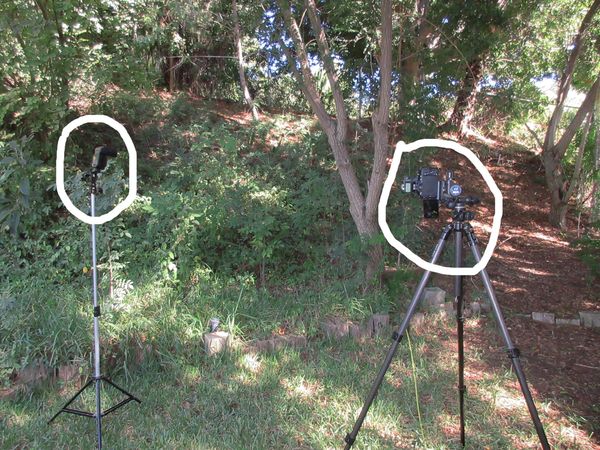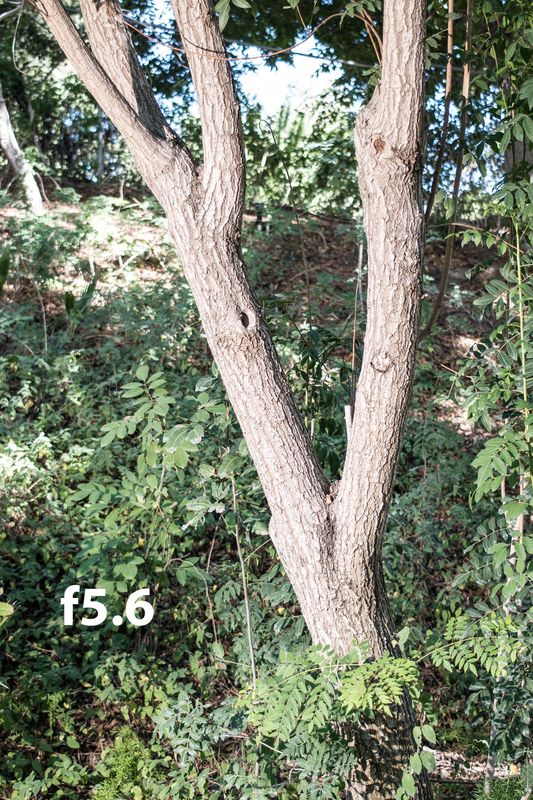What f-stop should I set my flash?
Nov 13, 2018 20:33:54 #
kenArchi wrote:
When I set my camera at f-5.6, 1/60 second to take a picture of my subject, what f-stop should I set my flash?
If you aren't using TTL on the flash set the flash and camera to the same f-stop.
Nov 13, 2018 20:44:12 #
kenArchi
Loc: Seal Beach, CA
I am here. With a complete report of my study.
You guys encouraged me to figure it out myself!
See you tomorrow.
You guys encouraged me to figure it out myself!
See you tomorrow.
Nov 13, 2018 21:12:24 #
Modern flashes read the camera's electronics and they select the appropriate amount of light for the flash exposure. Now, if you are talking about manual flash and you do not want to fool around with guide numbers simply meter the flash light and make the adjustment to get the amount of light needed for the aperture you want to use.
Nov 13, 2018 21:13:40 #
kenArchi wrote:
When I set my camera at f-5.6, 1/60 second
to take a picture of my subject, what f-stop
I set my flash?
When I set my camera at f-5.6, 1/60 second
to take a picture of my subject, what f-stop
I set my flash?
You should not match things in the manner
implied by your question. Read the chart or
dial on the flash and it will tell you what f/
stop to set on the camera. That's the order
in which to do it. Your question implies the
reverse order.
The type of flash that "demands" use of a
certain f/stop will also require that you
inform the flash of the ISO/ASA in use, by
setting the ISO/ASA on a dial or scale on
the camera. Often there will be a way to
select from 2 or more f/stops by setting a
color code opposite your ISO/ASA rating.
If the chart or dial on the flash does not
inform you of which f/stop to set on the
camera, your question does not apply to
the flash in question. Get a different flash
or ask a different question.
Before asking a different question, read
up on flash. If that's not a viable solution
learn to work without flash. Use ambient
light or an LED panel. You can even mix
LED and ambient light very easily. Since
both are constant light sources they are
less mysterious to the novice user. Your
normal camera light metering just takes
them "in stride", same as daylight.
There is really no reason for a complete
novice to struggle with flash. You can
use the fully matched flash from your
camera maker, or LED panels. The you
don't have any mysterious questions
about f/stops.
.
Nov 14, 2018 06:37:21 #
Bipod wrote:
This post mostly repeats what others have said, bu... (show quote)
All you do is blather on and on about trigger voltage.
Several times here, pretty silly sounding.
Nov 14, 2018 08:38:09 #
Nov 14, 2018 08:50:40 #
Nov 14, 2018 12:14:37 #
My Bad! It's an unmitigated waste of time and effort to attempt to answer a specific technical question without the OP supplying all the pertinent information regarding the equipment in question, its specifications and the intended usage. Instead of all the well meaning folks around here being able to supply a logical, practical and on-point answer, everyone ends up engaging in a game of "20 questions", some post in-depth answers based on assumptions rather than facts that shoud have been supplied by the OP and of course as usual, infighting and name calling ensues.
Then, there is the usual outpouring of completely inaccurate information, especially where electronic flash is concerned. I am not talking about different approaches or diversity of opinion- I mean data that is diametrically opposite to the truth! Of course, there is always is enough good information that an astute reader could process, piece together like a puzzle and manage to filter out all the nonsense. In these scenarios, the OP usually wanders off into the the sunset- probably gets a good laugh out of the chaos and seldom reciprocates with so much as a "thank you".
My bad is joining into theses threads. Folks who actually know what the are talking about and sincerely want to help others troubleshoot and learn about photography shoud direct their efforts to questions that have sensible,logical and discernible content. I'll try to to better.
Then, there is the usual outpouring of completely inaccurate information, especially where electronic flash is concerned. I am not talking about different approaches or diversity of opinion- I mean data that is diametrically opposite to the truth! Of course, there is always is enough good information that an astute reader could process, piece together like a puzzle and manage to filter out all the nonsense. In these scenarios, the OP usually wanders off into the the sunset- probably gets a good laugh out of the chaos and seldom reciprocates with so much as a "thank you".
My bad is joining into theses threads. Folks who actually know what the are talking about and sincerely want to help others troubleshoot and learn about photography shoud direct their efforts to questions that have sensible,logical and discernible content. I'll try to to better.
Nov 14, 2018 12:29:24 #
E.L.. Shapiro wrote:
My Bad! It's an unmitigated waste of time and eff... (show quote)
I totally agree with you on this one. I now really question the motive of the OP for posting the question I hope the OP doesn't have a mental problem.
Nov 14, 2018 16:55:51 #
Architect1776 wrote:
All you do is blather on and on about trigger voltage.
Several times here, pretty silly sounding.
Several times here, pretty silly sounding.
Pointless, unhelpful post. Totally ad hominem.
And inaccurate: I posted once on trigger voltage.
I'd hate to see someone fry their camera.
Don't you have something better to do than troll. Architect1776?
Nov 14, 2018 17:28:52 #
Bipod wrote:
Pointless, unhelpful post. Totally ad hominem.
And inaccurate: I posted once on trigger voltage.
I'd hate to see someone fry their camera.
Don't you have something better to do than troll. Architect1776?
And inaccurate: I posted once on trigger voltage.
I'd hate to see someone fry their camera.
Don't you have something better to do than troll. Architect1776?
The OP seemed unfamiliar with his flash unit and there are indications that it could ba an older auto system where the f/stop is set on the unit. Therefore, a cautionery warning about trigger voltage is not out of line. Nobody wants to see someone inadvertently damage their equipment.
Nov 17, 2018 18:02:48 #
kenArchi
Loc: Seal Beach, CA
Here is my test set-up and the results. Camera is set at f5.6, ISO 100, 1/60. All settings on camera and the TTL flash are in manual mode.
Picture 1, Camera and Flash set-up
Picture 2, Metering the flash. Reads f5.6
Picture 3, Photo at flash reading of f5.6
Picture 4, Photo at flash reading of f4.0. This picture is not as blown out as the f5.6 picture.
So, it appears that setting the flash at one f-stop less than the camera setting turns out to look pretty good.
So, maybe next I will set the flash system on TTL and see what flash reading I will get.
TTL in my experience is not always accurate, either too light or too dark. But that's another matter which I need to learn about how to use TTL to be more efficient.
So here I did a sample experiment to show and was not an armchair analyst and adviser.
Picture 1, Camera and Flash set-up
Picture 2, Metering the flash. Reads f5.6
Picture 3, Photo at flash reading of f5.6
Picture 4, Photo at flash reading of f4.0. This picture is not as blown out as the f5.6 picture.
So, it appears that setting the flash at one f-stop less than the camera setting turns out to look pretty good.
So, maybe next I will set the flash system on TTL and see what flash reading I will get.
TTL in my experience is not always accurate, either too light or too dark. But that's another matter which I need to learn about how to use TTL to be more efficient.
So here I did a sample experiment to show and was not an armchair analyst and adviser.




Nov 17, 2018 18:09:53 #
Your results are very strange. If the flash put out the same amount of light for the 2 shots the one with f/4.0 should be brighter. My estimate is that if you have your camera set on f/5.6, 1/60 and ISO 100 and don't use the flash your exposure would be either OK or or only slightly underexposed. In other word you have very high level of ambient light present.
Nov 17, 2018 20:33:51 #
Diamond41
Loc: St. Louis, MO
Based on what the OP wrote, I would agree with the earlier post to match the flash f-stop to the camera. I say that based the fact that current flash units, if match correctly, work with the camera to actually set flash output power. But that is the catch. Current digital cameras are designed to work with matched equipment to determine power needs.
If using an older flash the Guide numbers can be best way to go. But I have had many local pro's tell me not to use the older flashes with modern digital equipment. The flash power output will damage the camera over time.
If using an older flash the Guide numbers can be best way to go. But I have had many local pro's tell me not to use the older flashes with modern digital equipment. The flash power output will damage the camera over time.
Nov 18, 2018 07:40:23 #
If you want to reply, then register here. Registration is free and your account is created instantly, so you can post right away.






